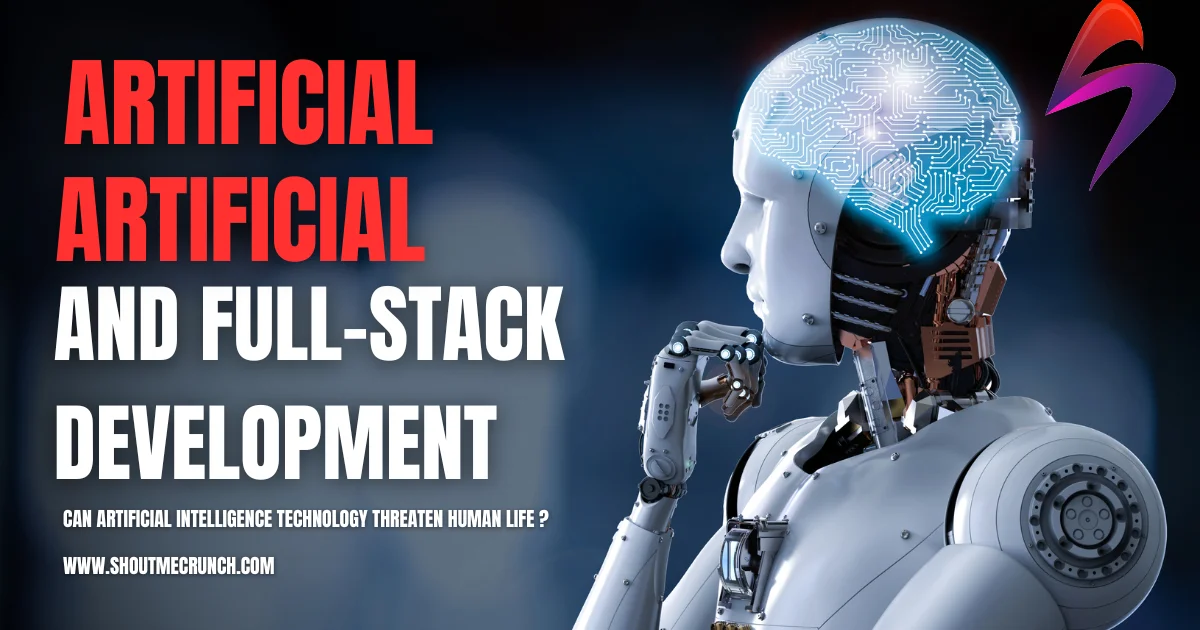In the dynamic landscape of technology, the convergence of Artificial Intelligence (AI) and Full-Stack Development has become a pivotal force, reshaping how applications are built and experienced. This article delves into the symbiotic relationship between AI and Full-Stack Development, exploring their integration on both the frontend and backend layers.
AI’s Integration in Full-Stack Development
Frontend Integration AI-driven User Interfaces
AI is revolutionizing user interfaces by making them more intuitive and responsive. Natural Language Processing (NLP) enables chatbots to understand and respond to user queries, providing a seamless interaction. This enhances user experience and reduces the burden on frontend developers to code every possible interaction manually.
Personalization and Recommendation Systems
AI algorithms analyze user behavior to offer personalized content and recommendations. Whether it’s suggesting products, content, or connections, these systems significantly enhance user engagement. Full-stack developers must now consider integrating AI models to tailor experiences based on individual user preferences.
AI-powered Data Processing and Analysis
In backend development, AI is harnessed for efficient data processing and analysis. Predictive analytics, for instance, allows systems to forecast trends and make data-driven decisions. This integration optimizes performance and enables applications to evolve based on real-time insights.
Automation of Server-side Tasks
AI-driven automation is streamlining server-side tasks, reducing the need for manual intervention. From resource allocation to load balancing, AI helps optimize server performance, ensuring applications run smoothly even under varying conditions. This automation allows developers to focus on higher-level tasks while AI manages routine backend operations.

Examples of AI Streamlining Development Workflows
Natural Language Processing (NLP) for Chatbots
Integrating NLP in chatbots empowers applications to understand and respond to natural language queries. This enhances user interaction and opens avenues for creating intelligent virtual assistants capable of handling complex conversations.
Image and Speech Recognition for Enhanced User Experiences
AI-powered image and speech recognition bring a new dimension to frontend development. From facial recognition for authentication to voice commands for navigation, these technologies enhance user experiences by providing innovative and user-friendly interfaces.
Predictive Analytics for Data-driven Decision-making
Backend systems can anticipate user behavior, trends, and potential issues by leveraging predictive analytics. This enables proactive decision-making, such as dynamically adjusting resources to accommodate increased demand or optimizing inventory based on predictive insights.
Automated Code Generation and Optimization
AI can assist developers in writing efficient code by automating certain aspects of the coding process. From suggesting code snippets to optimizing algorithms, these tools enhance productivity, allowing developers to focus on critical application logic and architecture elements.
Challenges in Adopting AI Across Full-Stack Layers
Integration Complexity
Integrating AI into front and back systems requires a deep understanding of AI frameworks and their compatibility with existing technologies. Developers face challenges in seamlessly incorporating AI models without disrupting the overall architecture.
Model Deployment and Maintenance
Deploying and maintaining AI models in a production environment can be challenging. Ensuring models are up-to-date, handling model drift, and addressing performance issues are ongoing concerns that developers must navigate.
Bias and Fairness in AI Algorithms
AI models are susceptible to biases in training data, which can result in discriminatory outcomes. Developers must be vigilant in addressing prejudice and ensuring fairness, considering the ethical implications of AI-driven functionalities.
Privacy Concerns with AI-driven Features
As AI systems handle increasingly sensitive information, privacy concerns become paramount. Developers must implement robust security measures to protect user data and comply with evolving privacy regulations.
Skillset Challenges for AI Integration
Upskilling Developers for AI Integration
Developers need to acquire new skills to navigate the integration of AI into full-stack development. This includes understanding AI algorithms, working with machine learning frameworks, and adapting to the evolving landscape of AI technologies.
Bridging the Gap Between AI and Traditional Development
There is often a gap between AI specialists and traditional developers. Bridging this gap is essential to foster collaboration and ensure effective communication between teams working on different technology stack layers.

Opportunities for Developers in Embracing AI
Streamlining Repetitive Tasks
AI excels at automating repetitive tasks, allowing developers to focus on more creative and strategic aspects of development. This not only boosts productivity but also fosters a more fulfilling work environment.
Accelerating Development Cycles
AI-driven tools and frameworks accelerate development cycles by automating testing, debugging, and optimization tasks. This speedier development process enables quicker delivery of features and updates to end-users.
Unleashing New Possibilities with AI-driven Features
AI opens new possibilities for innovative features and functionalities previously challenging to implement. Developers can explore novel concepts like real-time language translation, emotion recognition, and immersive augmented reality experiences.
Solving Complex Problems Through AI Solutions
AI provides powerful tools for solving complex problems, from optimizing resource allocation to predicting market trends. By incorporating AI solutions, developers can address challenges once considered impossible.
I have previously published many other articles. If you want to see them, click here.
- Future of AI-Generated Content for Web Development
- How is AI Used To Develop WordPress Website
- Future of Software Development
- Artificial Intelligence and Its Importance in Business
Understanding Full-Stack Development
Definition and Components
Full-stack development involves working on a web application’s client-side (front-end) and server-side (back-end). Front-end development focuses on creating user interfaces and experiences, while back-end development deals with server-side logic, databases, and application architecture. A Full-Stack Developer possesses a broad skill set, making them capable of handling various aspects of a project.
Evolution and Trends
Over the years, Full-Stack Development has evolved to meet the demands of a rapidly changing digital landscape. The rise of JavaScript frameworks like React and Angular has transformed front-end development, while back-end technologies like Node.js have gained prominence. The trend toward microservices architecture and the adoption of cloud computing has further shaped the Full-Stack Development paradigm.

Convergence of AI and Full-Stack Development
AI-Powered User Interfaces
One of the critical intersections of AI and Full-Stack Development lies in creating intelligent user interfaces. AI algorithms can analyze user behavior and preferences, enabling the development of interfaces that adapt and respond to individual needs. This personalization enhances the overall user experience, increasing user engagement and satisfaction.
Personalization and User Experience Enhancement
AI-driven personalization goes beyond recommending products or content. It involves understanding user preferences in real time and dynamically adjusting the interface to cater to them. This improves user satisfaction and contributes to higher conversion rates for businesses.
Real-World Applications Success Stories
Several companies have set exemplary standards in integrating AI and Full-Stack Development. Spotify uses AI algorithms to curate personalized playlists for users, while Tesla incorporates AI in its Full-Stack Development for self-driving car technology. These success stories highlight the transformative potential of combining AI and Full-Stack Development.
Conclusion
In the ever-evolving landscape of technology, the intersection of AI and Full-Stack Development presents a landscape ripe with opportunities and challenges. As developers navigate the integration of AI across frontend and backend layers, they find themselves at the forefront of innovation, shaping the future of applications and user experiences. By understanding and overcoming the challenges, developers can unlock the full potential of AI, enhancing productivity, fostering creativity, and delivering cutting-edge solutions to the world. Embracing the symbiosis of AI and Full-Stack Development is not just a choice; it’s a strategic imperative in the digital era.


